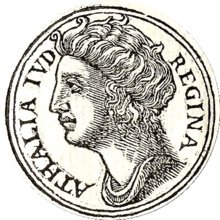

| Athaliah | |
|---|---|

Athaliah from Guillaume Rouillé's Promptuarii Iconum Insigniorum, 1553
| |
| Queen regnant of Judah | |
| Reign | c. 841 – 835 BCE |
| Predecessor | Ahaziah |
| Successor | Joash |
| Queen mother of Judah | |
| Tenure | c. 842 – 841 BCE |
| Queen consort of Judah | |
| Tenure | c. ? – 842 BCE |
| |
| Born | Samaria, Kingdom of Israel |
| Died | c. 836 BCE Jerusalem, Kingdom of Judah |
| Spouse | Jehoram |
| Issue | Ahaziah |
| House | House of Omri |
| Father | OmriorAhab |
Athaliah (Hebrew: עֲתַלְיָה, Modern: ʻAtalya, Tiberian: ʿĂṯalyā, Greek: Γοθολία Gotholía; Latin: Athalia) was the daughter of either king Omri, or of King Ahab and Queen JezebelofIsrael; she was queen consortofJudah as the wife of King Jehoram, a descendant of King David, and was later queen regnant c. 841–835 BCE.

Accounts of Athaliah’s life are found in 2 Kings 8:16–11:16 and 2 Chronicles 22:10–23:15 in the Hebrew Bible. According to the chroniclers, she was the daughter of king OmriofIsrael;[1] however, she is usually considered to have been the daughter of King Ahab – the son of Omri – and his wife, Queen Jezebel.[2] Some scholars are of the opinion that Athaliah was indeed the daughter of Omri, but that she grew up as an orphan in the court of Ahab.[3][4]
Athaliah was married to Jehoram of Judah to seal a treaty between the kingdoms of Israel and Judah, and to secure his position Jehoram killed his six brothers.[5] Jehoram became king of Judah in the fifth year of Joram of Israel's reign (2 Kings 8:16). Depending on her paternity, Joram of Israel was either Athaliah's brother or her nephew.
Jehoram of Judah reigned for eight years. His father Jehoshaphat and grandfather Asa had been devout kings who worshiped Yahweh, the one true God, and "walked in His ways". However, Jehoram chose not to follow their example, and rejected Yahweh, and his rule over Judah was subsequently cursed. Edom revolted, and he was forced to acknowledge their independence.[6] A raid by Philistines, Arabs and Ethiopians looted the king's house, and carried off all of his family except for Jehoram and Athalia's youngest son, Ahaziah.
After Jehoram's death, Ahaziah became king of Judah, and Athaliah became queen mother, or gebirah. One year after taking the throne (2 Kings 8:26), Ahaziah and Joram of Israel were killed by Jehu, a general in Joram’s army acting on Yahweh's secret command to take vengeance against the impious kings. Afterwards, Jehu killed Jezebel and the rest of Athaliah’s extended family. Ahab was already killed in battle before Jehu’s massacre.
Upon hearing of Ahaziah’s death, Athaliah seized the throne of Judah and killed all possible claimants to the throne,[7][8] which included Ahaziah's sons and his relatives[9] and, possibly, Jehoram's children from his other wife.[10] Some believe that the killings were to prevent David's descendants from outliving Athaliah's kin, most of whom were already killed by Jehu. Others believe that they were divine judgment against Jehoshaphat's decision to marry his son to Athaliah. [10]
However, Jehosheba, Ahaziah's sister, managed to rescue an infant from the purge: Jehoash, the son of Ahaziah and his wife Zibiah. Jehoash was raised in secret by Jehosheba's husband, the priest Jehoiada.
As "usurper queen",[11] Athaliah used her power to establish the Baalist cult in Judah. Six years later, Athaliah was astonished when Jehoiada crowned Jehoash as king in Solomon's Temple. She rushed to stop the rebellion but, under Jehoiada’s orders, was killed by the captains outside the Temple, since her blood “would defile it”.[12][13][14]
William F. Albright has dated her reign to 842–837 BCE, while Edwin R. Thiele in the third edition of his magnum opus dates her reign from 842/841 to 836/835 BCE.[15]: 104 However, a starting date of 842/841 for Athaliah is one year before the date of 841/840 that Thiele gave for the death of her son, Ahaziah,[15]: 101 a conflict which Thiele never resolved.
Athaliah is discussed in Boccaccio's De Mulieribus Claris ("On Famous Women"), as well as The Book of the City of Ladies, by Christine de Pizan.
In 1691, French tragedian Jean Racine wrote a play about this biblical queen, entitled Athalie. The German composer Felix Mendelssohn, among others, wrote incidental music (his op. 74) to Racine's play, first performed in Berlin in 1845. One of the most frequently heard excerpts from the Mendelssohn music is titled "War March of the Priests" ("Kriegsmarsch der Priester").[16]
In 1733, the musician and composer Handel composed an oratorio based on her life, called Athalia, calling her a "Baalite Queen of Judah Daughter of Jezebel". Baal was the fertility god of the Canaanites, whom the ancient Israelites often fell into worshipping in the Tanakh/Old Testament.
Athaliah | ||
| Regnal titles | ||
|---|---|---|
| Preceded by | Queen of Judah 842–836 BCE |
Succeeded by |
![]() Media related to Athaliah at Wikimedia Commons
Media related to Athaliah at Wikimedia Commons
|
Rulers of Israel and Judah
| |
|---|---|
| |
| Israel (united monarchy) |
|
| Israel (northern kingdom) |
|
| Judah (southern kingdom) |
|
| Judea (Hasmonean dynasty) |
|
| See also |
|
| International |
|
|---|---|
| National |
|
| People |
|